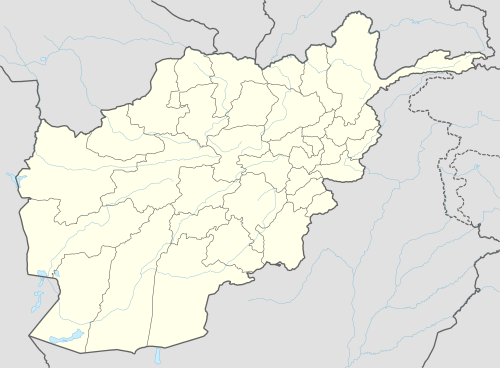Shortugai
 Shown within Afghanistan | |
| Location | Takhar Province, Afghanistan |
|---|---|
| Coordinates | 37°19′30″N 69°31′30″E / 37.32500°N 69.52500°ECoordinates: 37°19′30″N 69°31′30″E / 37.32500°N 69.52500°E |
| Type | Settlement |
| Area | Approximately 4 ha (9.9 acres) |
| History | |
| Cultures | Indus Valley Civilization |

Shortugai (Shortughai) was an Indus civilization trading colony established around 2000 BC on the Oxus river near the lapis mines in northern Afghanistan.[1][2] According to Sergent, "not one of the standard characteristics of the Harappan cultural complex is missing from it".[3]
The town consists of two hills called A and B by the excavators. One of them was once the town proper, the other one the citadel. Each of them is about 2 hectares large.
Findings
Typical finds of the Indus Valley Civilization include one seal with a short inscription,[4] clay models of cattle with carts[5] and painted pottery.[6] Pottery with Harappan design, jars, beakers, bronze objects, gold pieces, lapis lazuli beads, other types of beads, drill heads, shell bangles etc. are other findings.[7] Square seals with animal motiff and script confirms this as a site belonging to Indus Valley Civilisation (not just having contact with IVC).[7] Bricks had typical Harappan measurements.
Dryland farming
A ploughed field with flax seeds in this site indicate dry land farming and irrigation canals dug to bring water from Kokcha (25 km distance) also indicate efforts put in agriculture.[7]
Trading post
Shortugai was a trading post of Harappan times and it seems to be connected with lapis lazuli mines located in the surrounding area.[7] It also might have connections with tin trade (found at Afghanistan) and camel trade.[7]
References
- ↑ Kenoyer, Jonathan Mark (1998). Ancient cities of the Indus Valley Civilization. Oxford University Press. p. 96. ISBN 0-19-577940-1.
Another source of gold was along the Oxus river valley in northern Afghanistan where a trading colony of the Indus cities has been discovered at Shortughai. Situated far from the Indus Valley itself, this settlement may have been established to obtain gold, copper, tin and lapis lazuli, as well as other exotic goods from Central Asia.
- ↑ Bowersox, Gary W.; Chamberlin, Bonita E. Ph. D. (1995). "Gemstones of Afghanistan". Tucson, AZ: Geoscience Press: 52.. "During the height of the Indus valley civilization about 2000 B.C., the Harappan colony of Shortugai was established near the lapis mines."
- ↑ Bernard Sergent. Genèse de l'Inde, quoted by Elst 1999
- ↑ Francfort: Fouilles de Shortughai, pl. 75, no. 7
- ↑ Francfort: Fouilles de Shortughai, pls. 81-82
- ↑ Francfort: Fouilles de Shortughai, pls. 59-61
- 1 2 3 4 5 Singh, Upinder (2008). A History of Ancient and Early Medieval India : from the Stone Age to the 12th century. New Delhi: Pearson Education. p. 169. ISBN 9788131711200.
Further reading
| Wikimedia Commons has media related to Shortugai. |
- Henri-Paul Francfort: Fouilles de Shortughai, Recherches sur L'Asie Centrale Protohistorique Paris: Diffusion de Boccard, 1989